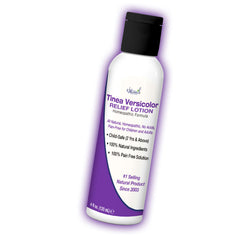Tiña versicolor
Cuando se trata de tiña versicolorLa causa es algo que vive de forma natural en la piel. Generalmente, la cepa de hongo (un tipo de Malassezia La levadura que causa esta decoloración generalmente vive de manera inofensiva y sin ser detectada en la piel; de hecho, la mayoría de las personas llevan este tipo de hongo en su piel sin ningún problema.
Sin embargo, en algunas personas, el hongo puede crecer demasiado o demasiado rápido, causando el síntoma característico de la tiña versicolor. Este crecimiento excesivo puede ocurrir por varias razones. En primer lugar, el clima cálido o húmedo, o las condiciones de vida, pueden acelerar el crecimiento de esta levadura. Los cambios en el cuerpo, incluyendo cambios hormonales y un debilitamiento... inmune sistemaTambién pueden ser factores causales. Las personas con piel grasa también pueden tener un mayor riesgo de desarrollar esta afección. Sin embargo, es importante destacar que la tiña versicolor es resultado de factores que afectan a los hongos naturales del cuerpo, por lo que no es contagiosa ni se contagia de otra persona.
Tiña (Tiña Corporis, Tiña Capitis y Tiña Cruris)
Esto es muy diferente de otras formas de tiña. La tiña (también conocida como tiña de la cabeza Si se desarrolla en el cuero cabelludo, la tiña crural o tiña inguinal si se presenta en las ingles o los glúteos, o la tiña corporal si se presenta en otras partes del cuerpo, no es en realidad una lombriz; esto es un error común. Como todos los tipos de tiña, se trata de una infección por hongos.
Estos hongos, conocidos como dermatofitos, también viven en la piel de las personas o animales afectados. Su crecimiento en la piel provoca una zona roja, elevada y con picazón, con piel más clara en el centro. Esta mancha roja, a menudo en forma de anillo, es de donde proviene el nombre común de "tiña".
Debido a su alta contagiosidad, la tiña es un hongo muy transmisible de persona a persona, o incluso de animal a persona. Los dermatofitos pueden vivir durante mucho tiempo en superficies blandas, como ropa de cama, toallas y prendas de vestir sin lavar, así como en superficies duras sin esterilizar, como equipos deportivos, superficies, cepillos y peines. Si toca estas superficies (o la piel afectada de una persona o animal con tiña) con su propia piel, y en particular si tiene alguna herida, es más probable que se transmita los dermatofitos.
Pie de atleta (tinea pedis)
Lo mismo ocurre con la tiña del pie, la infección micótica de los pies más comúnmente conocida como pie de atletaLos dermatofitos de otra persona con un caso actual de pie de atleta vivirán felizmente en el suelo durante largos períodos de tiempo; son especialmente capaces de prosperar y multiplicarse en condiciones húmedas, lo que hace que áreas como vestuarios, piscinas y duchas comunes sean grandes culpables de la propagación de la enfermedad.
Si camina descalzo en estas condiciones de humedad y una persona con pie de atleta ya ha pasado por allí, los dermatofitos podrían propagarse a su propia piel. Cuando este hongo se multiplica en la piel de los pies —acelerado por calcetines sudados o el uso prolongado de calzado cerrado—, también desarrollará los síntomas del pie de atleta.
Infecciones por hongos en las uñas (Tinea unguium)
Las mismas condiciones también pueden causar tiña ungueal, un tipo de infección por hongos en las uñas.Si padece un caso particularmente grave de pie de atleta, tiene las uñas dañadas o comparte cortaúñas o tijeras con alguien infectado, los dermatofitos también podrían invadir sus uñas. Al igual que ocurre con el pie de atleta, los dermatofitos presentes en piscinas o superficies húmedas, como el suelo de vestuarios o duchas comunes, también pueden causar tiña ungueal.






